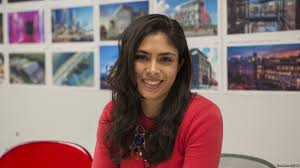(单词翻译:单击)
听力文本
Brazilian Zarela Mosquera moved to the United States as a teenager. The adjustment to a new place was difficult. Mosquera says she was a bratty teenager, as a result. But it was not just the adjustment that affected her behavior. Mosquera says there was another major stress in her life at that time: She was the only member of her family who spoke English.
"Being in a country with my family that doesn't speak Spanish and my parents don't really speak English, my parents were trying to give me all these responsibilities."
Along with Spanish and English, Mosquera also speaks Portuguese. But there was another universal language she learned to love as a child: art.
Mosquera connected with drawing and painting while in school. But she mostly dismissed art as a path to a career.
She says her Dad would always say, "Think about the future."
Mosquera did not think he would support the study of art once she went to college.
But, to her surprise, it was her parents who suggested just that. They urged her to apply to technical and liberal arts schools.
"One of them was Rhode Island School of Design so that was like my top choice."
RISD, as it is called, chose Mosquera as well. She enrolled in industrial design.
"It's basically to design products and services. I could be doing something more technical or something more related to problem solving. Whether it's figuring out a better way to filter water or developing a type of specific shelter for refugees for example."
Mosquera says the course of study was tough including metal working, woodworking and model making.
She says in one class she just drew cubes for an entire month, which led her to a question:
"Wow! Do I really want to do this?"
But, she says, she survived the cube study. And, then began working on more interesting projects.
"So you start kind of divinv more into the creative process when you have a strong foundation and design. And my school is really big on material understanding as well, which is why we're trained to use every imaginable tool there is like table saw, band saw everything because they give you an understanding of material. And when you have that understanding, that's when you can start designing things that are functional and also form driven."
Mosquera is now a design strategist for Marshall Moya Design, an architecture and interior design company in Washington, D.C.
Her job, Mosquera says, is to find the best solutions for a client need. She also supports the architecture team and branding department.
"I have experience in exhibit design, product design, website design and textiles. I've been using all of the experience that I've had and all the different skills that I've gained."
Mosquera also has a long-lived and deep interest in public art. This year, she helped create and design "The Walkway," for the D.C government.
"They wanted to see public art that was related to street harassment and to the public realm and how that affects pedestrian safety."
The creation was a 11-meter long tunnel-like structure. It was built to narrow sharply as the walker moves through. Bright lights change color along the path.
On the walls are images of people. Voices and city sounds are played through speakers installed in the walkway. At first, the recorded conversations and street noise and pictures have a positive feel. But the images and audio increase in intensity along the path. The experience becomes dark and violent in the middle part of the walkway.
"The purpose of showing these two different human emotions and human reactions is to allow people to reflect upon a variety of different expressions. So that brings up the conversation as to what is the right way to talk to each other in a public space. Should we talk to each other at all? So people are really questioning that. And that's what public art is meant to do."
For Mosquera, the form of the structure created the greatest impact.
"In a couple of steps, it changes pretty drastically and so actually feeling it versus just seeing it in a drawing was really impactful."
She enjoys developing public art in her free time, too.
"Throughout my career, I've picked up different things along the way. The best way to learn in my opinion is through working. Getting as many projects as you can. Industrial design kind of makes you a jack of all trades."
重点解析
1.as a result结果
As a result of all this, their incomes are up and land values have risen.
这一切的结果是,他们的收入增加了,土地的价值也上升了。
2.to her surprise令她惊讶的是
To her surprise, Premier Wen wrote back to her.
令她没想到的是,温总理真的回信了。
3.related to与…有关
And what is belief? It is a profound belief related to what you want to achieve.
那么什么是信念呢?它是一种和你想完成的事情有关的意义深远的信仰。
4.figure out想出;解决
Then figure out one practical solution you can take for each of those pieces.
接着想出一个实用性的方法用于解决每一小部分的问题。
5.bring up提出;带来
If the thought of your partner only brings up feelings of sadness and angry, it might be your heart’s way of telling you … Get out!
如果一想到对方让只能带来悲伤和怒火,那可能是你的心在对你说:离开吧!
6.pick up学会;捡起
I will probably pick up some new ideas and understanding from them, which I'll relay to you, the next time we meet.
或许我将会从他们那儿学到一些新的想法和认识,所有的这些,在下次我们相遇的时候,我都会教给你。
参考译文
扎瑞拉·莫斯克拉青少年时移居美国。适应新环境是艰难的,结果就是,莫斯克拉说她是个淘气的青少年。但是影响莫斯克拉行为的不仅是对环境的适应。莫斯克拉说那时生活中另外一个主要的压力就是,她是家庭中唯一一个会说英语的人。
“和我的家人一起住在一个不说西班牙语的国家,而且我父母也不说英语,父母把这些责任都给了我。”
除了西班牙语和英语,莫斯克拉也会说葡萄牙语。但是在童年时期,她也学着爱上了另外一种全球通用的语言:艺术。
莫斯卡拉在学校时迷恋上了画画。但是她没有考虑过将艺术作为自己的职业。
她父亲经常说,“考虑考虑未来吧”。
莫斯卡拉认为自己上大学后,父亲不会支持自己学艺术专业。
但是令她惊讶的是,她的父母鼓励自己学习艺术。他们敦促她申请技术和文科院校。
“其中一个建议就是罗得岛设计学院,所以这个就是我的首选。”
罗德岛设计学院也选择了莫斯卡拉。她学的是工业设计。
“工业设计基本上就是设计产品和服务。我可以做一些更加有技术含量或更贴近于解决问题的事情。无论是找到更好的过滤水的方法,还是为难民开发一种特殊的避难所。”
莫斯克拉说,这门课程非常艰苦,需要学习金属加工、木工和模型制作等知识。
她说在一次课上她画了整整一个月的立方体,这让她产生了一个问题:
“哇!这真的是自己想做的事情吗?”
但是,她说自己熬过了立方体相关课程的学习。而且,后来的课程更有趣了。
“所以当你有很好的基础和设计能力之后,你就能更好的投入创造的过程了。我的学校也非常注重对材料的理解,这就是为什么学校训练我们去使用所有能想到的工具比如桌锯,带锯,因为它们能让你理解材料。当你有了那种理解之后,你就可以从功能和形态出发设计东西了。”
莫斯卡拉现在是马歇尔莫亚设计公司的一名设计策略师,这是一家位于华盛顿特区的建筑和室内设计公司。
莫斯卡拉说自己的工作就是针对客户需求寻求最好的解决方案。
她还参与建筑团队和品牌推广部门的工作。
“我有展览设计,产品设计,网站设计和纺织品方面的经验。我一直在利用我所有的经验和我所获得的各种技能。”
长久以来,莫斯卡拉对公共艺术也有深厚的兴趣。今年,她参与创造设计了为哥伦比亚特区设计的“特别通道”。
他们希望看到与街头骚扰和公共领域相关的公共艺术,以及它们如何影响行人安全。这个通道是一个11米长的隧道状结构。
在步行者通过它时它会急剧变窄。沿着小路向前走,明亮的灯光会改变颜色。
墙上挂着人的肖像。人们的声音和城市的声音通过安装在人行道上的扬声器播放。首先,录下来的对话和街道上的噪音和图片给人一种积极的感觉。但是图像和音频的强度会随着路径的延伸而增加。在走道中间,人们会转而体验到黑暗和暴力。
“展示这两种不同的人类情感和人类反应的目的是让人们反思各种不同的表达方式。这就引出了关于在公共空间中什么是正确的交谈方式的话题。我们应该互相交谈吗?所以人们真的在思考这个问题。这就是公共艺术的意义所在。”
对莫斯克拉来说,这个建筑的形态创造出了最大的效果。
“在通道中,短短几步,人们的感觉就会急剧的变化,所以相比于只是看它的设计图,真的去体验它的话,效果会好很多。”
莫斯克拉在自己的闲暇时间也喜欢创造公共艺术。
“在我的职业生涯中,我学到了很多东西。在我看来,学习的最好方式就是工作。努力获得尽可能多的项目。某种程度上,做工业设计让人成为一个样样都懂的人。”
译文为可可英语翻译,未经授权请勿转载!


